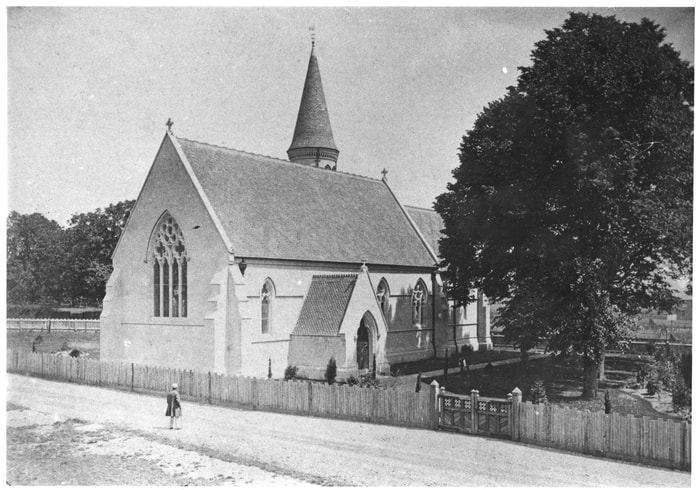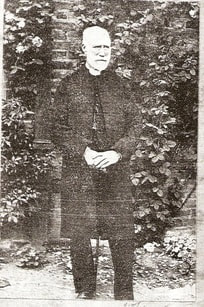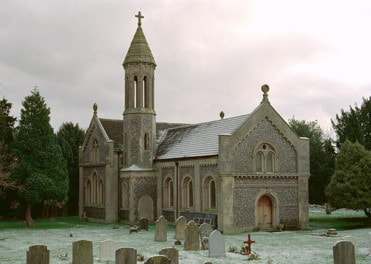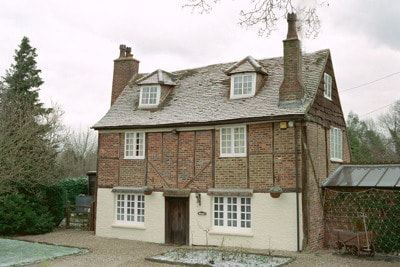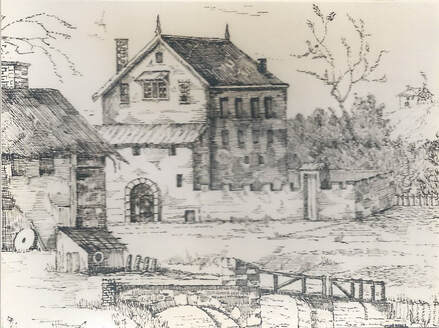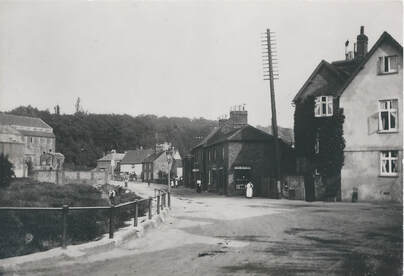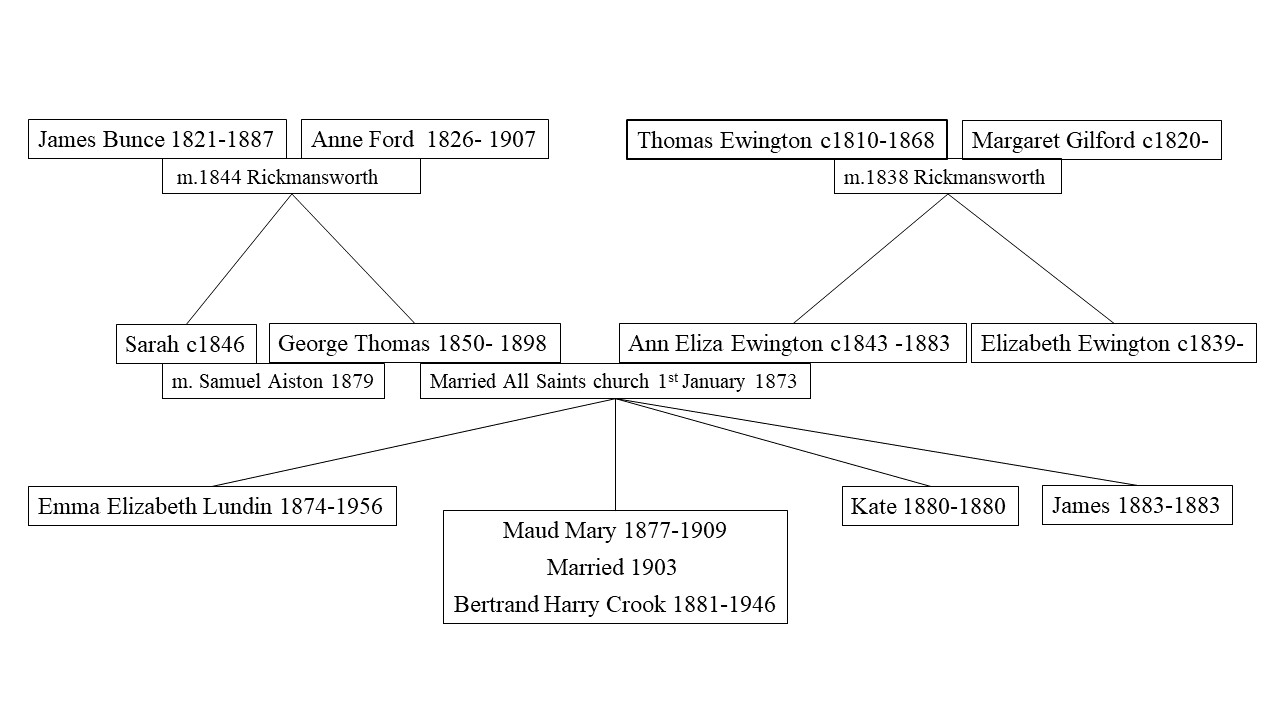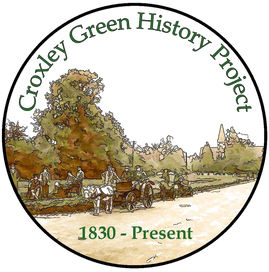The First Wedding held at All Saints Church
The first wedding in All Saints Church took place on New Years Day, 1st January 1873. It was celebrated by the Reverend Astley Roberts and the entry he made in the Register of Marriages shows that the groom was George Thomas Bunce, a coachman aged 24, and the bride was Eliza Ann Ewington, spinster, aged 27. The Register also gives details of the fathers of the couple, and of the witnesses to the marriage: George’s father was James, a publican, who lived in Horn Hill, and Eliza’s was Thomas, a labourer, deceased. Their witnesses were James Bunce (George’s father) and Elizabeth Ewington (Eliza’s sister).
At this period it was quite common for marriages to take place on festival days, especially around Christmas, when the ‘twelve days of Christmas’ lasted until Epiphany on 6th January. Church fees were sometimes reduced at these times, as so many ceremonies took place. It was also a time when working people might have had a rare free day to join in the celebrations. The form of the ceremony would have been much as it is nowadays, with the banns being read for the preceding three Sundays. The vows that the couple would take would of course have included the promise by the bride to ‘obey’ her husband, which is usually omitted today.
The degree of elaboration would depend on the funds available to the families. It would be quite common for the bride to be dressed in white – Queen Victoria had set that fashion – and she might well have had several bridesmaids also in white. If there were real flowers available in January, they would probably have had headdresses or posies to carry. After the actual wedding, there would have been a celebration either in one of the homes, or in a local pub. Unfortunately, there is no record of what George and Eliza did.
At this period it was quite common for marriages to take place on festival days, especially around Christmas, when the ‘twelve days of Christmas’ lasted until Epiphany on 6th January. Church fees were sometimes reduced at these times, as so many ceremonies took place. It was also a time when working people might have had a rare free day to join in the celebrations. The form of the ceremony would have been much as it is nowadays, with the banns being read for the preceding three Sundays. The vows that the couple would take would of course have included the promise by the bride to ‘obey’ her husband, which is usually omitted today.
The degree of elaboration would depend on the funds available to the families. It would be quite common for the bride to be dressed in white – Queen Victoria had set that fashion – and she might well have had several bridesmaids also in white. If there were real flowers available in January, they would probably have had headdresses or posies to carry. After the actual wedding, there would have been a celebration either in one of the homes, or in a local pub. Unfortunately, there is no record of what George and Eliza did.
Who Were George and Eliza?
George was born on 9th March 1850, in West Hyde. He was christened a month later in St. Thomas of Canterbury Church, West Hyde. At that time, his father James, aged 29, was a farm bailiff, and his mother Ann was aged 27. The 1851 Census shows that George had an elder sister, Sarah, aged 4, and that the family were living in West Hyde. James Bunce was employed by Richard Morten, a wealthy farmer and miller, who lived at Pynesfield Farm, West Hyde, where he farmed 1700 acres, employing 68 men and 42 boys. In 1863 Morten purchased Overs Farm (later called Gellibrands) near Horn Hill Court.
George probably received a basic education at the nearby May House, then used as a school. (The 1861 Census lists him as a scholar.) Parents were charged a penny a week for tuition. By 1862 a purpose built school was built near St. Thomas of Canterbury, overseen by the church.
It is not known what George did once he left school, probably at the age of 12, but it is almost certain he would have joined his father in working on one of Richard Morten’s farms, as the 1871 Census lists him as a coachman employed by Louisa Morten, widow of Richard, at Blakes Court, a farm of 130 acres. It was here that he would have met Eliza, as she was employed as a housemaid at Blakes Court.
George was born on 9th March 1850, in West Hyde. He was christened a month later in St. Thomas of Canterbury Church, West Hyde. At that time, his father James, aged 29, was a farm bailiff, and his mother Ann was aged 27. The 1851 Census shows that George had an elder sister, Sarah, aged 4, and that the family were living in West Hyde. James Bunce was employed by Richard Morten, a wealthy farmer and miller, who lived at Pynesfield Farm, West Hyde, where he farmed 1700 acres, employing 68 men and 42 boys. In 1863 Morten purchased Overs Farm (later called Gellibrands) near Horn Hill Court.
George probably received a basic education at the nearby May House, then used as a school. (The 1861 Census lists him as a scholar.) Parents were charged a penny a week for tuition. By 1862 a purpose built school was built near St. Thomas of Canterbury, overseen by the church.
It is not known what George did once he left school, probably at the age of 12, but it is almost certain he would have joined his father in working on one of Richard Morten’s farms, as the 1871 Census lists him as a coachman employed by Louisa Morten, widow of Richard, at Blakes Court, a farm of 130 acres. It was here that he would have met Eliza, as she was employed as a housemaid at Blakes Court.
Less is known about Eliza. She was born c1847. According to the 1861 Census, the family lived in Batchworth. Her father Thomas was a farm labourer and her mother Margaret worked in a paper mill, almost certainly in the mill at Batchworth owned by John Dickinson. Eliza also worked at a paper mill, and her sister Elizabeth was a dressmaker. At some time, Eliza must have found employment in domestic service.
Married Life
For a short while after their wedding, George and Eliza lived on Scots Hill, where their first daughter, Emma Elizabeth, was born in 1874. George was still working as a coachman to Louisa Morten, who now lived at The Court Farm, where she employed 38 men, 15 boys and 5 women on a farm of 986 acres. At some point, George and Eliza moved to Horn Hill. Their second daughter, Maud Mary, was born in 1877. A third daughter, Kate, was born and died in 1880. Their son, James, was born in 1883, and in the same year James and Eliza both died.
George moved to Batchworth, Rickmansworth and became a self-employed Fly Proprietor – a fly was a single horse-drawn carriage which could be hired with a driver. He died in October 1898.
For a short while after their wedding, George and Eliza lived on Scots Hill, where their first daughter, Emma Elizabeth, was born in 1874. George was still working as a coachman to Louisa Morten, who now lived at The Court Farm, where she employed 38 men, 15 boys and 5 women on a farm of 986 acres. At some point, George and Eliza moved to Horn Hill. Their second daughter, Maud Mary, was born in 1877. A third daughter, Kate, was born and died in 1880. Their son, James, was born in 1883, and in the same year James and Eliza both died.
George moved to Batchworth, Rickmansworth and became a self-employed Fly Proprietor – a fly was a single horse-drawn carriage which could be hired with a driver. He died in October 1898.
Children
Emma (1874-1956)
The 1881 Census shows the family living in Horn Hill, and Emma’s birth place was Scots Hill. By the 1891 Census, Emma, aged 16, is working as an Elementary School Teacher in a National School, living in Batchworth, Rickmansworth, with her father George, her sister Maud Mary and her aunt Elizabeth Ewington, who had no doubt stepped in to care for the family after the death of her sister Eliza. Ten years later, the 1901 Census shows Emma living independently as a boarder with another teacher, Elizabeth Wingrove, in Grosvenor Place, Talbot Road, Rickmansworth. Her career as a teacher continued, but she moved far from Rickmansworth. The 1911 Census lists her in Ilfracombe, Devon, in lodgings with a retired butcher and his family. Emma was now an Assistant Teacher employed by the Devon County Council. She never married and died in April 1956 in Dawlish, Newton Abbot, Devon.
Maud (1877-1909)
Maud, born in 1877, lived with her family in cottages called Jelly Brands (later Gellibrands), in Horn Hill. The 1891 Census records that Maud, aged only 14, was an Elementary School Teacher in a National School. By this time the family, which then consisted of father George, sister Emma and aunt Elizabeth, was living in Batchworth. By the time of the 1901 Census, Maud was in London, employed as Hospital Nurse in a private nursing home in Bulstrode Street.
At some point she met Bertrand Harry Crook, who had been born in 1881 in Waddesdon, Buckinghamshire. They were married in Hampstead, London, in 1903. Nothing else has been discovered about their life together, not even whether they had children, but Maud’s death is recorded in Barnstaple, Devon, in 1909. (Could it be she – or they – had moved to be nearer Emma?) Bertrand outlived his wife by more than 30 years, dying in 1946 at the Fielding Johnson Hospital, Leicester.
Emma (1874-1956)
The 1881 Census shows the family living in Horn Hill, and Emma’s birth place was Scots Hill. By the 1891 Census, Emma, aged 16, is working as an Elementary School Teacher in a National School, living in Batchworth, Rickmansworth, with her father George, her sister Maud Mary and her aunt Elizabeth Ewington, who had no doubt stepped in to care for the family after the death of her sister Eliza. Ten years later, the 1901 Census shows Emma living independently as a boarder with another teacher, Elizabeth Wingrove, in Grosvenor Place, Talbot Road, Rickmansworth. Her career as a teacher continued, but she moved far from Rickmansworth. The 1911 Census lists her in Ilfracombe, Devon, in lodgings with a retired butcher and his family. Emma was now an Assistant Teacher employed by the Devon County Council. She never married and died in April 1956 in Dawlish, Newton Abbot, Devon.
Maud (1877-1909)
Maud, born in 1877, lived with her family in cottages called Jelly Brands (later Gellibrands), in Horn Hill. The 1891 Census records that Maud, aged only 14, was an Elementary School Teacher in a National School. By this time the family, which then consisted of father George, sister Emma and aunt Elizabeth, was living in Batchworth. By the time of the 1901 Census, Maud was in London, employed as Hospital Nurse in a private nursing home in Bulstrode Street.
At some point she met Bertrand Harry Crook, who had been born in 1881 in Waddesdon, Buckinghamshire. They were married in Hampstead, London, in 1903. Nothing else has been discovered about their life together, not even whether they had children, but Maud’s death is recorded in Barnstaple, Devon, in 1909. (Could it be she – or they – had moved to be nearer Emma?) Bertrand outlived his wife by more than 30 years, dying in 1946 at the Fielding Johnson Hospital, Leicester.
Sources
The West Hyde Story, E.H. Ruffett, 1957. (He was a past headmaster of West Hyde School)
Family Search website
Free Birth Marriages Death (BMD) website
Census 1861, 1871, 1881, 1891, 1901, 1911 through the FindMyPast/Ancestry websites
The West Hyde Story, E.H. Ruffett, 1957. (He was a past headmaster of West Hyde School)
Family Search website
Free Birth Marriages Death (BMD) website
Census 1861, 1871, 1881, 1891, 1901, 1911 through the FindMyPast/Ancestry websites
